|
|
|
Sort Order |
|
|
|
Items / Page
|
|
|
|
|
|
|
| Srl | Item |
| 1 |
ID:
166984
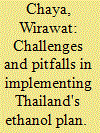

|
|
|
|
|
| Summary/Abstract |
Thailand's ethanol policy is embedded in the Alternative Energy and Development Plan 2015 (AEDP 2015). The policy goal is to increase ethanol production and consumption in 2036 at 223% of the baseline in 2015. A large demand for feedstock supplies, mainly molasses and cassava to meet the policy target causes concerns over their sufficiency. However, oversupply of ethanol has been observed occasionally. Since ethanol production and consumption are relevant to a number of policies, incoherence and gaps may contribute to the shortcomings. By applying a combined coherence and gap analysis, it is shown that crop zoning is irrelevant to and ineffective in securing the supply of ethanol. On the other hand, demand saturation is primarily due to the ineffectiveness of the state mechanisms. Key factors contributing to the problem are low prices of crude oil, high prices of feedstocks, managing availability of and accessibility to certain types of blended fuels in favor of the low blended ones, incorrect understanding of consumers towards high blended fuels and the public's recent interest towards electric vehicles. Political factors may also account for the slow-growing demand. The developed method is proved to be useful in determining effectiveness of interrelated policies dealing with ethanol.
|
|
|
|
|
|
|
|
|
|
|
|
|
|
|
|
| 2 |
ID:
149491
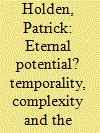

|
|
|
|
|
| Summary/Abstract |
Temporality is a relatively under-explored factor in international relations. The concept of timescape refers to the temporal timeframe of institutional processes and/or the timeframes of causation at different levels. Said concept has powerful explanatory potential in the case of complex, fragmented entities such as the European Union (EU). Critical realism offers a historicist meta-theoretical framework for delineating and analysing timescapes of different forms. Theories of critical political economy and historical sociology can be used to critique the EU’s own liberal teleological timescapes. The Union’s leadership postulates a central future role for it, based on its long-term structural relationships, and its Mediterranean policy is a prime example of this structural foreign policy. However, its component structures are profoundly dissonant and unlikely to coalesce into a meaningful role. The EU’s engagement in the Mediterranean illustrates how its long-term approach is over-ridden by the ‘real-time’ agency of other actors, and by deeper socio-economic cycles which it cannot control. A focus on temporality thus helps to interpret and explain the fragmented power of the EU; as well as our complex international system more generally.
|
|
|
|
|
|
|
|
|
|
|
|
|
|
|
|
| 3 |
ID:
127017
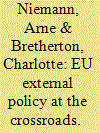

|
|
|
|
|
| Publication |
2013.
|
| Summary/Abstract |
The goal of this Special Issue is to improve our conceptualisation and empirical understanding of EU actorness and effectiveness in International Relations. While the European Union aspires to play a greater global role, its actorness and effectiveness cannot be taken for granted given the nature of the EU as a multi-level and semi-supranational polity encompassing 28 Member States with diverse foreign policy preferences. The EU is presently at an important crossroad. On the one hand, its external policy stature and capacity have been boosted by institutional innovations and by the Union's increased involvement in the full spectrum of international issues. On the other hand, a number of factors cast doubt on the EU's real external policy actorness and effectiveness: slow and often only modest internal reforms, an increasing politicisation of formally 'low politics' issues, the prolonged sovereign debt crisis in the Eurozone, and a less favourable external environment, with the US shifting its focus to the Asia-Pacific region and emerging powers creating a more polycentric world order. In view of these changes and subsequent developments in the scholarly literature, our aim is to re-evaluate earlier conceptions of EU actorness. Central to this re-evaluation will be a shift in focus from notions of actorness to effectiveness. This introductory article will unpack and further elaborate the issues raised in this abstract by delineating the EU as an international actor in the empirical context, by reviewing the existing conceptual literature, defining and conceptualizing key notions and by providing an overview of the contributions to this Special Issue.
|
|
|
|
|
|
|
|
|
|
|
|
|
|
|
|
| 4 |
ID:
100923
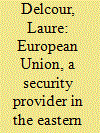

|
|
|
|
|
| Publication |
2010.
|
| Summary/Abstract |
This article analyses the extent to which and the way in which the European Union (EU) has acted as a security provider in its eastern vicinity since the European Neighbourhood Policy was launched. The EU's capacity to emerge as a security provider and the approaches developed in this purpose are gauged against three major EU objectives in the eastern neighbourhood: conflict resolution, control of migration flows and good governance. The article sustains that EU efforts to reach objectives which it considers important for regional security are undermined by a lack of coherence in policy implementation across the eastern neighbourhood.
|
|
|
|
|
|
|
|
|
|
|
|
|
|
|
|
| 5 |
ID:
127018
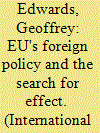

|
|
|
|
|
| Publication |
2013.
|
| Summary/Abstract |
The Lisbon Treaty sought to meet new global challenges by providing the European Union (EU) with stronger institutional capacity and policy instruments to make it a more effective international actor in foreign and security terms. The article sets out the structures and practices agreed and contested by both Member States - especially the United Kingdom and France - and the European Commission, focusing on the roles of the High Representative (HR) for Foreign Affairs and the European External Action Service. It points to the disjuncture between the formal calls for greater coherence and consequence in the EU's foreign policies, the problems of creating an effective policy vehicle and the practices that undermine both its efforts and its legitimacy.
|
|
|
|
|
|
|
|
|
|
|
|
|
|
|
|
| 6 |
ID:
184112


|
|
|
|
|
| Summary/Abstract |
Export controls of dual-use products and sanctions on respective items are highly regulated in the European Union (EU). However, we find multiple instances of implementation and application problems of dual-use control in the Member States. To explain this puzzling observation, we investigate the relationship between the institutional design of sanctions and their subsequent implementation and application. Drawing on rational design theory, we argue that even if coherence is the EU’s stated goal, the institutional design of the current dual-use export control regime is inadequate to provide for coherence. National licensing decisions and a constant need for the interpretation of contingent rules in the implementation and application of dual-use sanctions are structural challenges to establish a coherent European policy. The relationship between institutional design and coherence, which we investigate in the context of sanctions, is not specific to the EU. Instead, we offer a novel conceptual and analytical tool to study the expected degree and causes of (in-)coherence in the implementation and application of any regime of international sanctions.
|
|
|
|
|
|
|
|
|
|
|
|
|
|
|
|
| 7 |
ID:
096202
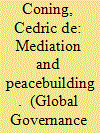

|
|
|
|
|
| Publication |
2010.
|
| Summary/Abstract |
This article focuses on the role of the special representative of the Secretary-General (SRSG) in the context of UN integrated missions. The article argues that the primary leadership function of the SRSG is to facilitate a process that generates and maintains strategic direction and operational coherence across the political, governance, development, economic, and security dimensions of a peacebuilding process. The power and influence of the SRSG does not reside in the resources that he or she can directly bring to bear on a specific situation, but in the ability to muster and align the resources of a large number of agencies, donors, and countries to support the peacebuilding effort in a given context. This type of leadership role implies that persons with skills, experience, and a personality suited to multistakeholder mediation and negotiations are more likely to be successful SRSGs than someone who is used to top-down, autocratic, military, private sector, or direct-control type leadership styles. This perspective on the role of the SRSG has important implications for the way in which people are chosen and prepared for these positions, as well as for the ways in which support can be provided for this role, both at the United Nations and in the field.
|
|
|
|
|
|
|
|
|
|
|
|
|
|
|
|
| 8 |
ID:
104600
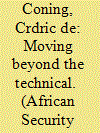

|
|
|
| 9 |
ID:
170753
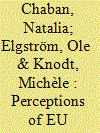

|
|
|
|
|
| Summary/Abstract |
A small but growing literature has started to analyse the European Union (EU) ‘as an effective peacemaker’. We make a contribution to this field by investigating EU mediation effectiveness in the Russia–Ukraine conflict. The focus is on perceptions of effectiveness. Based on information from semi-structured interviews, we compare EU self-images with Ukrainian evaluations of EU mediation efforts. How effective is the EU, including its Member States, deemed to be? What factors are believed to lie behind perceived (in)effectiveness? We concentrate on four such factors, derived from the mediator literature: perceived (im)partiality, coherence and credibility and, finally, evaluations of the EU’s mediation strategies. Both internal and external views singled out EU member states as the most effective actors in current mediation. The role of EU was seen in ambivalent terms by both sides. All the four determinants of mediation effectiveness are discussed in our material, but differ considerably in the degree of attention given to each of them. While (im)partiality is not a factor that is linked to effectiveness in any straightforward way, EU incoherence is associated with inconsistent and weak policies, notably in the Ukraine material.
|
|
|
|
|
|
|
|
|
|
|
|
|
|
|
|
| 10 |
ID:
166781


|
|
|
|
|
| Summary/Abstract |
Coherence is a core objective in most multinational interventions and seems of particular relevance to UN peacekeeping missions with their increasing complexity and multidimensionality. Yet, coherence has rarely been studied empirically. We borrow the concept of ‘fit’ from organizational theory and use it to develop a conceptual framework to study coherence in peacekeeping operations. Fit is the degree of match between what is required by the mandate, on the one hand, and an institutional set-up and the implemented practices, on the other. We identify three relevant dimensions of fit to study coherence: strategic and organizational, cultural and human and operational fit. Our empirical material focuses on the UN mission in Mali (MINUSMA) and in particular on the interplay between the intelligence components and the rest of the mission. We draw upon a large empirical dataset containing over 120 semi-structured interviews, field observations and participation in pre-deployment exercises and evaluation sessions. Our empirical analysis suggests that low level of fit across several dimensions leads to inertial and widespread frictions in the practice of peacekeeping and could potentially undermine peacekeeping effectiveness. Building on existing scholarship on micro-level approaches to peacekeeping, we hope to further the debate on organizational dynamics within peace operations.
|
|
|
|
|
|
|
|
|
|
|
|
|
|
|
|
|
|
|
|
|